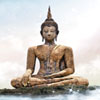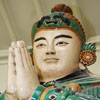Meng Tse On The Origins Of Buddhist Philosophy
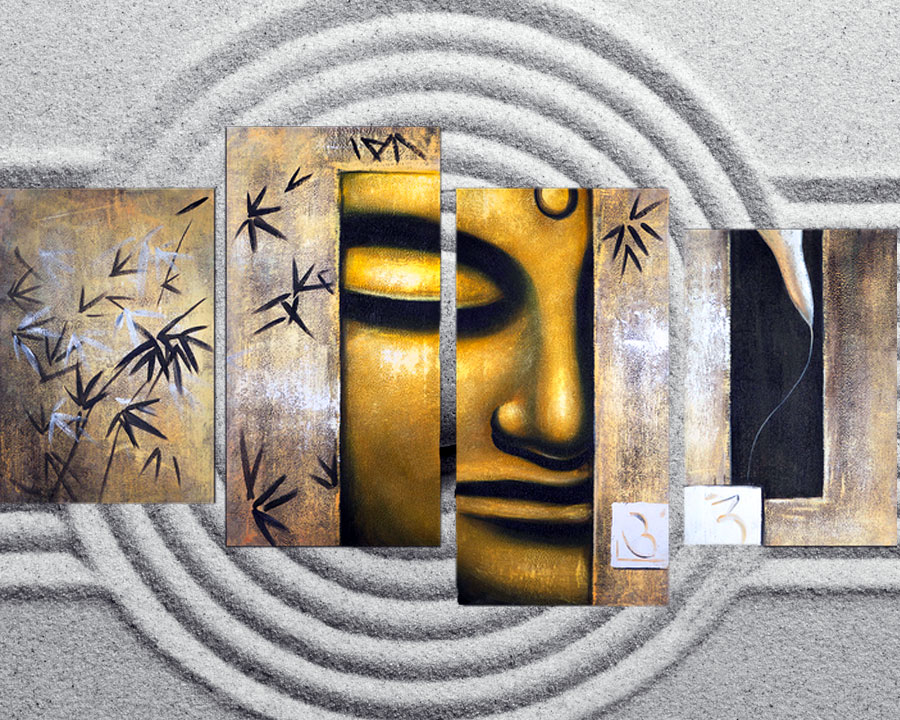 Greetings to my dear earth brothers and sisters; may I first say that I am so happy to come to you and to be of some service to you. I can be known in the
Greetings to my dear earth brothers and sisters; may I first say that I am so happy to come to you and to be of some service to you. I can be known in the 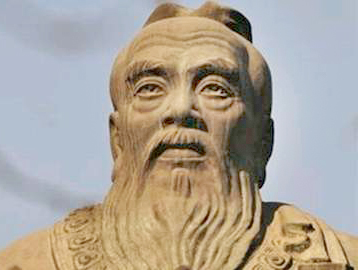 future as the personal identity of a small Chinaman who lived about a hundred years after Kung Fu, and was known as Mencius or Meng Tse. I have been given the privilege of conducting you through this great city of Helianthus; and we are about ready to somewhat explore the sections which are more immediately concerned with your earth history. However, before we go into this section, we shall pause in this beautiful parkway and discuss something more of the philosophies of Hinduism while your eyes are becoming accustomed to what you see about you.
future as the personal identity of a small Chinaman who lived about a hundred years after Kung Fu, and was known as Mencius or Meng Tse. I have been given the privilege of conducting you through this great city of Helianthus; and we are about ready to somewhat explore the sections which are more immediately concerned with your earth history. However, before we go into this section, we shall pause in this beautiful parkway and discuss something more of the philosophies of Hinduism while your eyes are becoming accustomed to what you see about you.
The text of Buddha, in itself, was simply one which he largely devoted to the explanation of the origin of the different phases of Hinduism as they exist much as they do in India today. He was, during his earth life, very greatly shocked a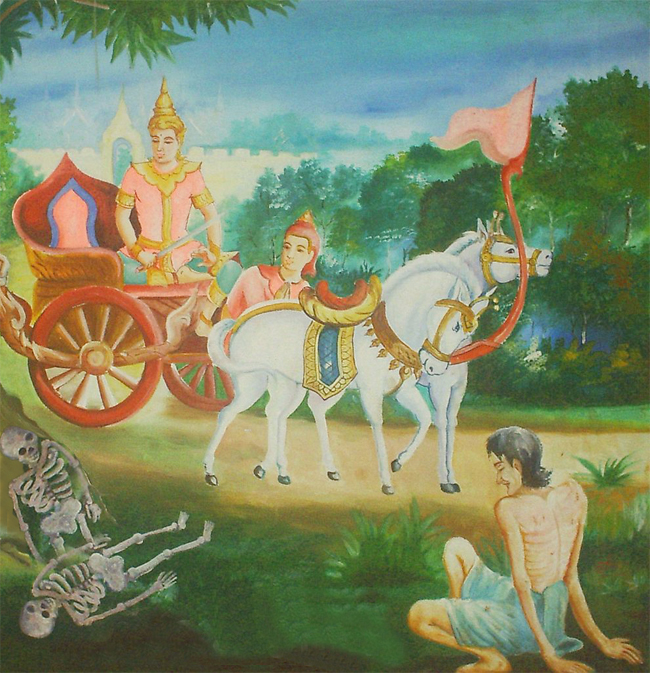 t seeing the suffering of the peoples who believed they were practicing the true monistic God Principles by this perversion and abuse of their bodies. The version of the Brahmanistic concepts or the Vedic translations as they have been so warped and distorted were completely vilified in many ways by the individual known as Brahavara, the person who became known as the god Janus. Buddha pointed this out specifically, knowing that no harm would come from this direct finger pointing at this individual, because he knows that this person has, since that time, come into a place of spiritual understanding; and although he did set aside the divine conception of Brahma — the triad of Brahma, Vishnu and Shiva — yet, since that day, he has worked out and expiated his crime, and was enabled to reincarnate into your world and was known as the Mahatma Gandhi.
t seeing the suffering of the peoples who believed they were practicing the true monistic God Principles by this perversion and abuse of their bodies. The version of the Brahmanistic concepts or the Vedic translations as they have been so warped and distorted were completely vilified in many ways by the individual known as Brahavara, the person who became known as the god Janus. Buddha pointed this out specifically, knowing that no harm would come from this direct finger pointing at this individual, because he knows that this person has, since that time, come into a place of spiritual understanding; and although he did set aside the divine conception of Brahma — the triad of Brahma, Vishnu and Shiva — yet, since that day, he has worked out and expiated his crime, and was enabled to reincarnate into your world and was known as the Mahatma Gandhi.
So now you see that while we may have been ostracized very definitely for criticizing an individual, yet it 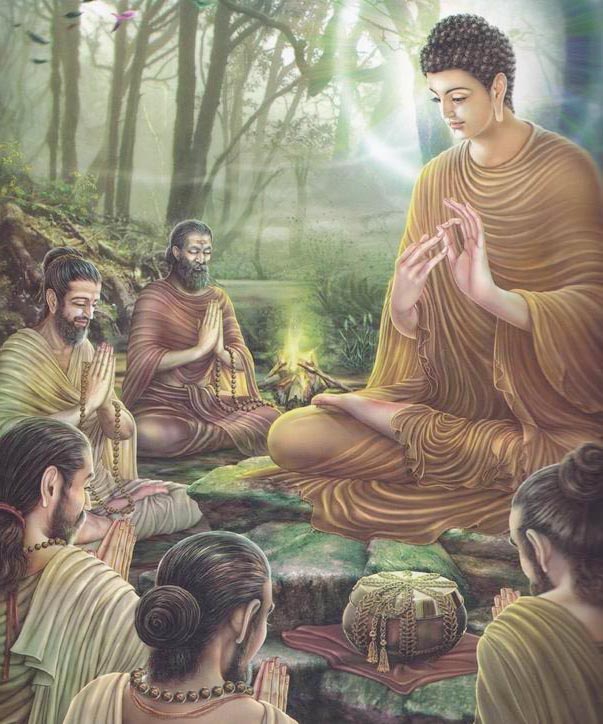 was not the individual we criticized, but rather the work that person did while he was on the earth. The whole superconsciousness of the individual, as you see, went through a great metamorphosis in a spiritual dimension, and so he completely worked out his karma by serving mankind in a very large and in a very humble capacity. Buddha, himself, is a very humble person; he did not very fully enlarge upon the simplicity of the spiritual concepts as he so tried to teach them on the earth at that time. Buddhism, as it existed some time after his death and as it still exists today, was not strictly the philosophy which he taught, but just as in the case of Christianity, the various concepts suffered a great deal of distortion in recurring as a definite philosophy in the future years of evolution. Buddha did little or no writing, himself, but was followed about by a number of disciples or apostles just as was Jesus.
was not the individual we criticized, but rather the work that person did while he was on the earth. The whole superconsciousness of the individual, as you see, went through a great metamorphosis in a spiritual dimension, and so he completely worked out his karma by serving mankind in a very large and in a very humble capacity. Buddha, himself, is a very humble person; he did not very fully enlarge upon the simplicity of the spiritual concepts as he so tried to teach them on the earth at that time. Buddhism, as it existed some time after his death and as it still exists today, was not strictly the philosophy which he taught, but just as in the case of Christianity, the various concepts suffered a great deal of distortion in recurring as a definite philosophy in the future years of evolution. Buddha did little or no writing, himself, but was followed about by a number of disciples or apostles just as was Jesus.
One of these persons was a very avid disciple by the name of Upolia. It was Upolia who became known as the St. Paul of Buddha and it was he who wrote the numerous transcripts known as the ‘Tripitaka’, or the ‘Three Baskets of Bread’, wherein were contained the Ten Commandments of Buddha.
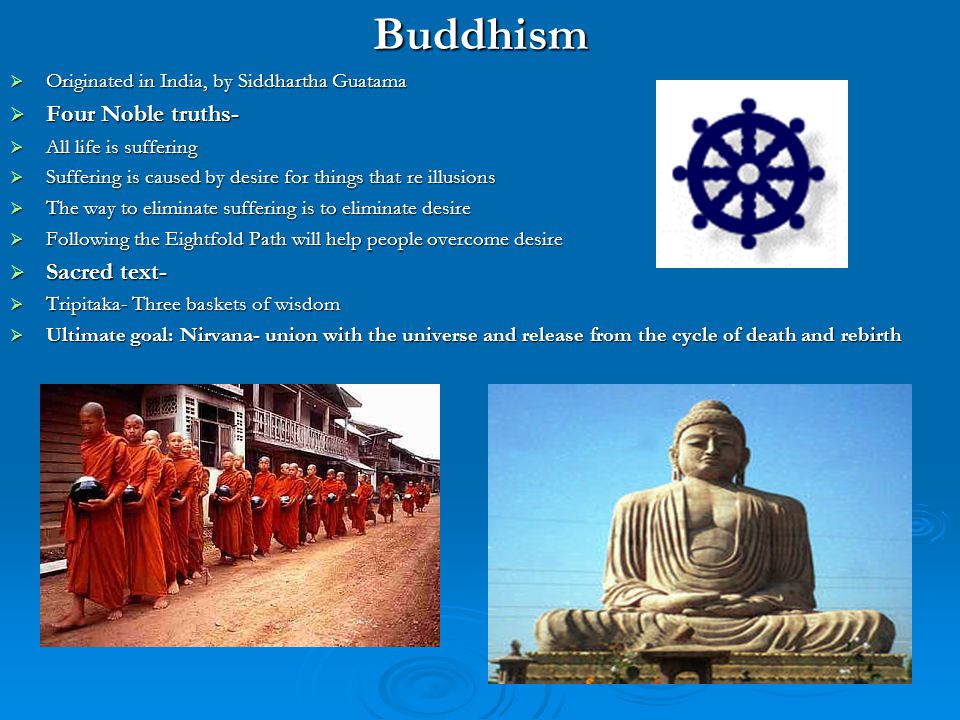
If you will note the first one which says, “Thou shalt not kill any living thing”; this was an old Brahmanical concept which had been handed down through the Vedic laws. Buddha was very temperate in all his philosophies. He said, “Thou shalt not kill”, but he meant, “Thou shalt not kill thy brother or sister”; and there were other distortions, or shall I say different interminglings of various kinds of personal ideas into the original Buddhistic concept. If you will read your history books, you will see that Jesus, like Buddha, did not come into his expression of Christianity until the time of Constantine, who, at that time, established what was to become the Roman Catholic Church, and contributed to the reestablishing of the Byzantine Empire, or to filling the original concept as it was so begun in Greece.
The parallel here with Buddhism is very marked; the concept of Buddha was known only locally in his own province, and it did not come into its own until about three hundred years later under the reign of King Asoka, who became a very devout follower of Buddha and succeeded in propagating this concept into the far reaches of India.
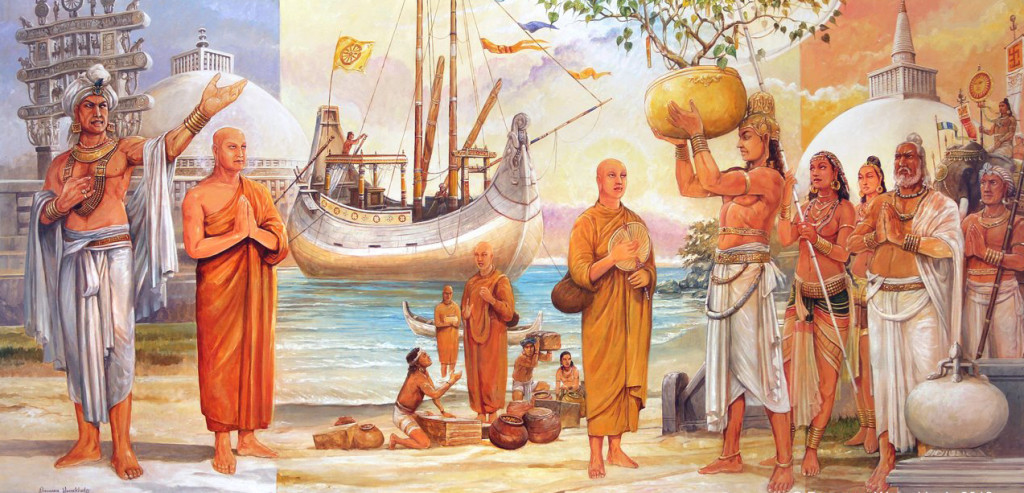 Hinduism or Buddhism, as it exists in India today, is a very strong intermingling of all the old concepts of Brahminisms and the Triad of Brahma as it existed, including the various types of pantheism which are known as Jainism, and the different interpretations of Buddha. You might say that India is universally under one flag or banner; they all have somewhat the same intermingling of concept, and during these many thousands of years since, have become thoroughly intermingled. You will notice also that many of the early travelers in India were quite surprised to see the Christian cross and other symbols which were used in Buddhism or in the concepts of Hinduism. This was simply because that intercourse or traveling was carried on throughout the many thousands of years; and India was not, as was commonly supposed, completely isolated from the Western world.
Hinduism or Buddhism, as it exists in India today, is a very strong intermingling of all the old concepts of Brahminisms and the Triad of Brahma as it existed, including the various types of pantheism which are known as Jainism, and the different interpretations of Buddha. You might say that India is universally under one flag or banner; they all have somewhat the same intermingling of concept, and during these many thousands of years since, have become thoroughly intermingled. You will notice also that many of the early travelers in India were quite surprised to see the Christian cross and other symbols which were used in Buddhism or in the concepts of Hinduism. This was simply because that intercourse or traveling was carried on throughout the many thousands of years; and India was not, as was commonly supposed, completely isolated from the Western world.
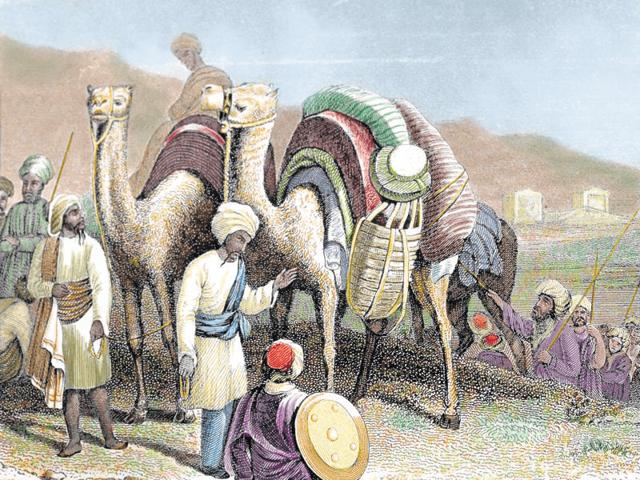 The Greeks, the Jews, and the Egyptians very often came into India in the various caravans or perhaps they came individually and so carried with them, not only some of the ritualism and beliefs of their own native country, but also carried back to these same countries some of the beliefs of the Hinduism or Buddhism as they had so seen and witnessed in the various ceremonies.
The Greeks, the Jews, and the Egyptians very often came into India in the various caravans or perhaps they came individually and so carried with them, not only some of the ritualism and beliefs of their own native country, but also carried back to these same countries some of the beliefs of the Hinduism or Buddhism as they had so seen and witnessed in the various ceremonies.
Now, just a word more about the concept of, shall I say, astrophysics, as it was somewhat explained to you in a previous transmission of the thirty-three radial dimensions as they are expressed from the Great Central Temple here. You will see certain insignia above the great entrance ways into these different thirty-three sections. The sections themselves relate to the periods or cycles of one thousand years as they are portrayed in magnetic line structures of the solar system in which 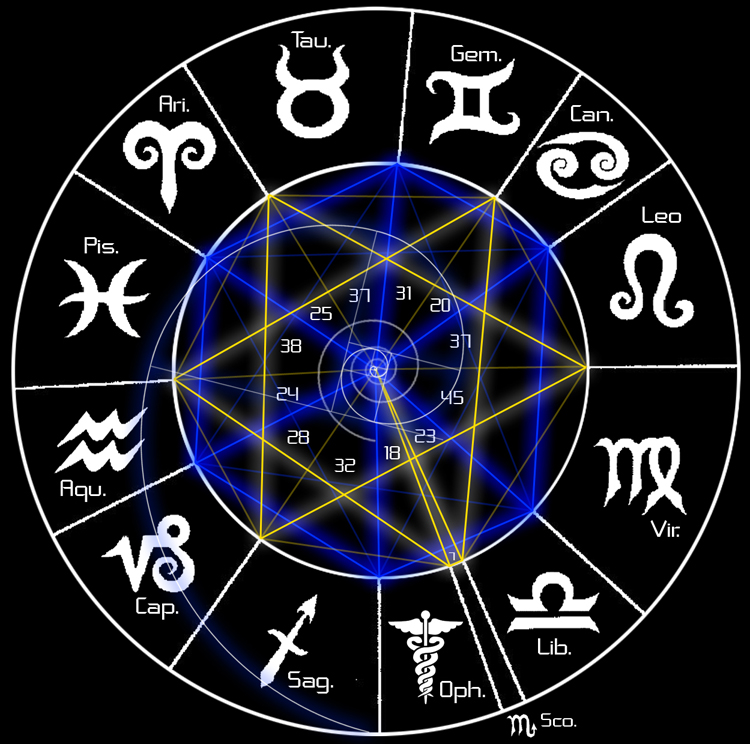 you are now residing. The solar system is so linked and counterlinked with the Central Vortex of the great universe. The one-thousand year cycles are conjunctions of spiritual force of these thirty-three centers wherein renewed impingements or modulations of spiritual nature are intermingled with these magnetic lines of structures. The task of further propagating or stimulating spiritual guidance and growth of mankind upon the earth and into other places of the galaxy, known as the universe, is carried on in the twelve sub-divisions or sections which we manifest here from this Shamballa. They, in turn, take up this work in these twelve divisions which are actually about two-thousand seven-hundred and fifty years. These sections, in themselves, are somewhat of the astrological nature or interpretation as they have been so devised upon the earth plane. They will start from Pisces and continue on around through Aquarius. All in all, it can be said to be a very cleverly devised way in which these great minds have so conceived to interject the various spiritual knowledge and wisdom and to further enhance the value of man’s progression in the lower dimensions.
you are now residing. The solar system is so linked and counterlinked with the Central Vortex of the great universe. The one-thousand year cycles are conjunctions of spiritual force of these thirty-three centers wherein renewed impingements or modulations of spiritual nature are intermingled with these magnetic lines of structures. The task of further propagating or stimulating spiritual guidance and growth of mankind upon the earth and into other places of the galaxy, known as the universe, is carried on in the twelve sub-divisions or sections which we manifest here from this Shamballa. They, in turn, take up this work in these twelve divisions which are actually about two-thousand seven-hundred and fifty years. These sections, in themselves, are somewhat of the astrological nature or interpretation as they have been so devised upon the earth plane. They will start from Pisces and continue on around through Aquarius. All in all, it can be said to be a very cleverly devised way in which these great minds have so conceived to interject the various spiritual knowledge and wisdom and to further enhance the value of man’s progression in the lower dimensions.
This is somewhat in the form of personal intercession, as it might be said, in that these very strong spiritual rays are constantly within the superconsciousness of the individuals as they reside in these lower dimensions. However, I do believe that in the future you will evaluate these concepts in your own way and in your own mind.
Now let us go directly into this first great section, which you see has over the doorway, as part of the insignia, two very strange-looking forms of fishes which have their tails entwined about each other; they 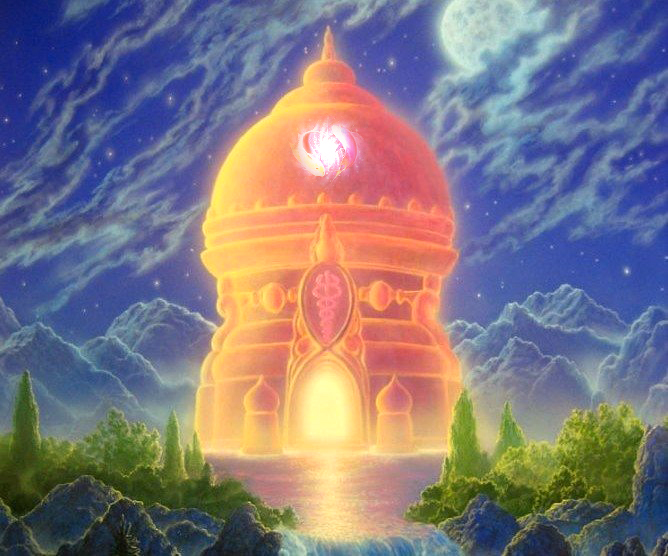 seem to be standing on their tails with their mouths open wide, and they have huge staring eyes. This, the sign of Pisces, denotes the two states of consciousness within the concept of man, his karmic or material state of consciousness and his spiritual state of consciousness. We can be assured that which we find within this temple will be, at least, mostly associated with the earth and its evolution within the last two thousand years. However, for purposes of further including or intermingling these different concepts, much within each of these temples is sometimes duplicated within one or another of the other sections. This is for the purpose, as you will see, of acquainting the many large groups of the many thousands of students who remain within these great sections for many hundreds of years or until they have assimilated the knowledge which is necessary for them to progress further.
seem to be standing on their tails with their mouths open wide, and they have huge staring eyes. This, the sign of Pisces, denotes the two states of consciousness within the concept of man, his karmic or material state of consciousness and his spiritual state of consciousness. We can be assured that which we find within this temple will be, at least, mostly associated with the earth and its evolution within the last two thousand years. However, for purposes of further including or intermingling these different concepts, much within each of these temples is sometimes duplicated within one or another of the other sections. This is for the purpose, as you will see, of acquainting the many large groups of the many thousands of students who remain within these great sections for many hundreds of years or until they have assimilated the knowledge which is necessary for them to progress further.
Now that we are directly inside, the first sight which greets your eye is a huge Hindu temple. You, dear sister and brother, saw such a picturization on your TV screen quite recently, and we can enlarge this 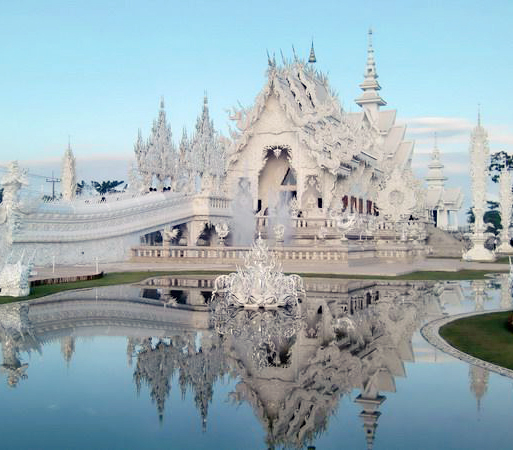 concept; as you can see, it does bear somewhat the same resemblance of the numerous and intricate maze of spires and various other types of very finely devised symbols which are on the outside of this great edifice. This temple is called the Temple of Manu, or the law maker. It was Manu who so brought, conceived, and interwove into the original Vedic transcripts the concept of Brahma, Vishnu, and Shiva. Brahma, as you know, is the Infinite Conception; he is supposed to be the great Celestial or Causal world of spiritual interpretation. Vishnu is the more immediate or pranic world which was symbolized as a great god who lived from the sun. It was Shiva who became the giver of life, or that from Shiva was expressed the numerous karmic laws of reincarnation. The spiritual as well as the physical nature of man was contained within these concepts of reincarnation. Coming down through the many hundreds of years, or even thousands of years since the time of Man, these concepts were so warped and distorted within man’s consciousness that much of their purity and spiritual virtue was lost.
concept; as you can see, it does bear somewhat the same resemblance of the numerous and intricate maze of spires and various other types of very finely devised symbols which are on the outside of this great edifice. This temple is called the Temple of Manu, or the law maker. It was Manu who so brought, conceived, and interwove into the original Vedic transcripts the concept of Brahma, Vishnu, and Shiva. Brahma, as you know, is the Infinite Conception; he is supposed to be the great Celestial or Causal world of spiritual interpretation. Vishnu is the more immediate or pranic world which was symbolized as a great god who lived from the sun. It was Shiva who became the giver of life, or that from Shiva was expressed the numerous karmic laws of reincarnation. The spiritual as well as the physical nature of man was contained within these concepts of reincarnation. Coming down through the many hundreds of years, or even thousands of years since the time of Man, these concepts were so warped and distorted within man’s consciousness that much of their purity and spiritual virtue was lost.
Man contrives into himself, through the numerous complexes of guilt which were incurred in his nature, to change these concepts to suit his own taste or purpose. This is a universal custom and is not completely confined to the concepts of Hinduism. The same practice goes on in all churches and in all synagogues on the earth today. Man is continually changing the innermost divine concepts to something which he can orient within his own way of life or thinking, or that he can so expiate some sense of guilt within himself by saying that God has punished him, or that he might say, “Ho, I need not worry. Jesus will save me, etc.”
This great temple, as you see, seems to be glittering with gold; it is indeed some such material in its very highly developed spiritual form. The various intricate, sculpturings and c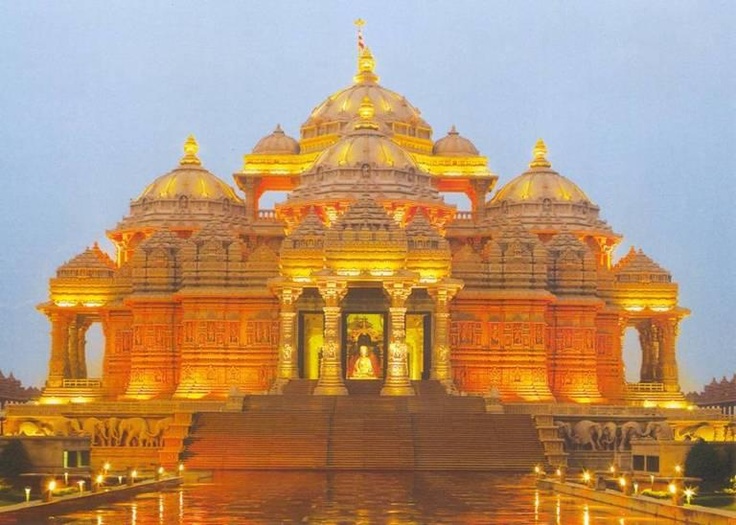 arvings which cover the outside surface of this great temple, the small figures and gargoyles, the fishes; these, and the infinite number of types of symbols as they are so fabricated are, in themselves, pageantry of history; and they are also devised in many of the temples of India today. The meanings of these symbols and the portent which is contained therein have been lost in antiquity. The Hindu of today does not know how to interpret the spiritual meanings of the numerous figures which he handed down from generation to generation. He has no knowledge of carving or so contriving these figures in the walls of his temples; he does not know how to correctly translate them. Within this temple you will find the numerous translations of the original Vedic texts as they were so contained at the time of migration from the plane of Mongolia. These texts were extracts or derivations of the spiritual truths which were handed down to man from the old original Shamballa which existed on the great crystal plateau in Central Mongolia.
arvings which cover the outside surface of this great temple, the small figures and gargoyles, the fishes; these, and the infinite number of types of symbols as they are so fabricated are, in themselves, pageantry of history; and they are also devised in many of the temples of India today. The meanings of these symbols and the portent which is contained therein have been lost in antiquity. The Hindu of today does not know how to interpret the spiritual meanings of the numerous figures which he handed down from generation to generation. He has no knowledge of carving or so contriving these figures in the walls of his temples; he does not know how to correctly translate them. Within this temple you will find the numerous translations of the original Vedic texts as they were so contained at the time of migration from the plane of Mongolia. These texts were extracts or derivations of the spiritual truths which were handed down to man from the old original Shamballa which existed on the great crystal plateau in Central Mongolia.
So, all in all, you can see that the modern concepts of Hinduism bear only a small resemblance to the original spiritual philosophy which was so handed down to man from this great Shamballa. Such context of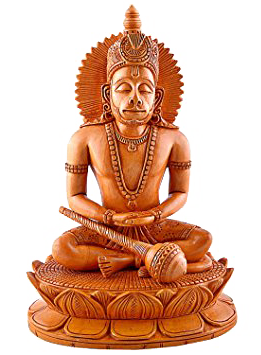 material is necessarily confined in its expression and in its nature into something which man has conceived to be purposes of self-punishment or infliction, or that he must adopt and stand for many hours in different postures, or lay in cramped positions, or to such supposedly inducive meditative processes whereby he can communicate with his inner nature. We would like to point out that these concepts, as they are so contained in the expression of Hinduism in your time, are not, in the general sense of the word, entirely practical to the working out in your world or sphere of reincarnation. Nor, could you so properly work out any karmic influence which is contained in your past histories by so sitting for many hours in constant meditation upon the inner nature.
material is necessarily confined in its expression and in its nature into something which man has conceived to be purposes of self-punishment or infliction, or that he must adopt and stand for many hours in different postures, or lay in cramped positions, or to such supposedly inducive meditative processes whereby he can communicate with his inner nature. We would like to point out that these concepts, as they are so contained in the expression of Hinduism in your time, are not, in the general sense of the word, entirely practical to the working out in your world or sphere of reincarnation. Nor, could you so properly work out any karmic influence which is contained in your past histories by so sitting for many hours in constant meditation upon the inner nature.
While we say that a great degree of consciousness within this inner 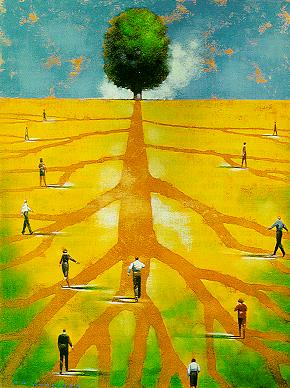 nature, or inner self is of the utmost importance; yet this should not be set aside, nor should the individual delete the purposes of his incarnation into the earth. It must be remembered that according to the laws of frequency relationship in the various cycles in which the karma was incurred, that the individual subconsciously comes into the time and place when these karmic conditions will be remanifasted into his life in such a way that he will be able to largely rectify them by suffering some sort of a small psychic shock wherein the elements of different time consonants are of such nature that it also aids in rectifying these conditions of impingements or wave forms in his psychic body. You can reasonably see that any one who would sit upon the temple steps for weeks and years in a meditative position would not be in such a conducive phase of his life whereby he could work out these different karmic structures in his psychic anatomy.
nature, or inner self is of the utmost importance; yet this should not be set aside, nor should the individual delete the purposes of his incarnation into the earth. It must be remembered that according to the laws of frequency relationship in the various cycles in which the karma was incurred, that the individual subconsciously comes into the time and place when these karmic conditions will be remanifasted into his life in such a way that he will be able to largely rectify them by suffering some sort of a small psychic shock wherein the elements of different time consonants are of such nature that it also aids in rectifying these conditions of impingements or wave forms in his psychic body. You can reasonably see that any one who would sit upon the temple steps for weeks and years in a meditative position would not be in such a conducive phase of his life whereby he could work out these different karmic structures in his psychic anatomy.
The world of maya, or the material world about you, is one which was largely conceived, and of which you 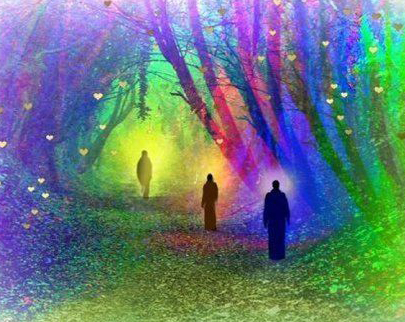 largely conceived yourself to be a part; and so in working through these different dimensions of maya or illusions, you incurred these karmic conditions. It is your purpose to come back into these different worlds until you have progressed to such a point where you can become more dominant with these conditions, and that you can more thoroughly regulate the progression of cycles in your own earth life. This begins your evolution into the higher dimensions.
largely conceived yourself to be a part; and so in working through these different dimensions of maya or illusions, you incurred these karmic conditions. It is your purpose to come back into these different worlds until you have progressed to such a point where you can become more dominant with these conditions, and that you can more thoroughly regulate the progression of cycles in your own earth life. This begins your evolution into the higher dimensions.
The posture of meditation and inward consciousness 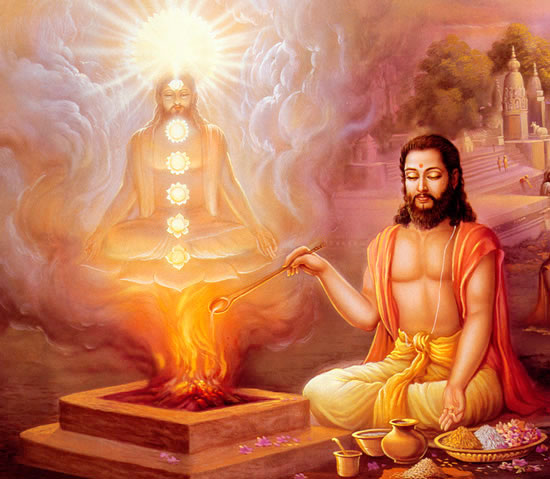 were meant primarily, or they should be exercised only by individuals who were called Yogis. These individuals had, in themselves, a complete state of dominion of consciousness, so that they could — through these meditative processes — completely separate themselves from their physical bodies at any time which they so chose. I might point out that these practices are very dangerous for the initiate or to the person who is not thoroughly familiar with the ways and the knowledge of spiritual transformation, for he could incur a great deal of trouble and run afoul of some very definite spiritual obsessions if he so entered into such practices without being thoroughly schooled in such practices before he indulged in them.
were meant primarily, or they should be exercised only by individuals who were called Yogis. These individuals had, in themselves, a complete state of dominion of consciousness, so that they could — through these meditative processes — completely separate themselves from their physical bodies at any time which they so chose. I might point out that these practices are very dangerous for the initiate or to the person who is not thoroughly familiar with the ways and the knowledge of spiritual transformation, for he could incur a great deal of trouble and run afoul of some very definite spiritual obsessions if he so entered into such practices without being thoroughly schooled in such practices before he indulged in them.
If you were to go to India today, you would see many people who go about with hooks and skewers in their 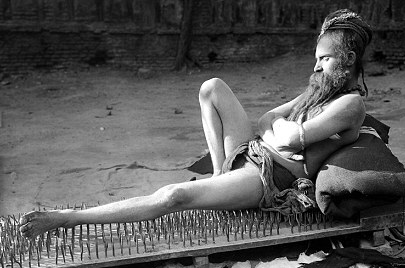 bodies, and as they thought, were punishing themselves for some small infraction of the law or that they might be adopting the numerous torturous postures and remain seemingly suspended in a catalytic state for hours or days and even years at a time. Such an individual is, in himself, and to a large degree, simply stopping his spiritual evolution. He has come to the point where the various guilt complexes in his nature were so strong that he must retreat into some sort of psychic trance, wherein he believes that he is working out his salvation. This is contrary to the law of frequency relationship, in working out these karmic conditions which incurred the guilt complexes.
bodies, and as they thought, were punishing themselves for some small infraction of the law or that they might be adopting the numerous torturous postures and remain seemingly suspended in a catalytic state for hours or days and even years at a time. Such an individual is, in himself, and to a large degree, simply stopping his spiritual evolution. He has come to the point where the various guilt complexes in his nature were so strong that he must retreat into some sort of psychic trance, wherein he believes that he is working out his salvation. This is contrary to the law of frequency relationship, in working out these karmic conditions which incurred the guilt complexes.
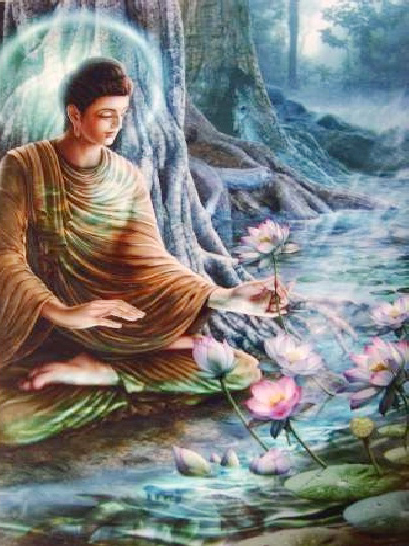 It was Buddha who tried to teach that such practices were contrary to the general law, and, in so teaching, he aroused a great deal of resentment; he had to so modify his teachings which would somewhat conform with the general ideas and practices as they existed in his time. The mere idea of teaching people to discard caste systems, as they had been in their social structures for thousands of years, was, in itself, something which aroused a great deal of antagonism. Therefore, Buddha had to more or less float with the stream in order to sow the seed which he hoped would develop into a more factual philosophy. So you see, dear ones, that in India, even though it is a land of strange mystery and strange cults and practices, these practices of cultisms, of Brahma, and Hinduism, as they are expressed as religions, are not entirely practical nor are they entirely without the element of error.
It was Buddha who tried to teach that such practices were contrary to the general law, and, in so teaching, he aroused a great deal of resentment; he had to so modify his teachings which would somewhat conform with the general ideas and practices as they existed in his time. The mere idea of teaching people to discard caste systems, as they had been in their social structures for thousands of years, was, in itself, something which aroused a great deal of antagonism. Therefore, Buddha had to more or less float with the stream in order to sow the seed which he hoped would develop into a more factual philosophy. So you see, dear ones, that in India, even though it is a land of strange mystery and strange cults and practices, these practices of cultisms, of Brahma, and Hinduism, as they are expressed as religions, are not entirely practical nor are they entirely without the element of error.
These elements of error are so contained in all of the 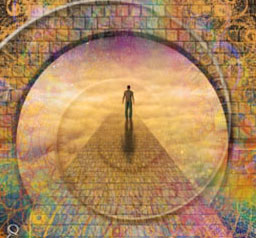 religions of the world; they are contained in Christianity, in Judaism and in many other interpretations of life. There is, at present, a third dimension of expression which is trying to sweep through the world and overpower all such spiritual concepts; and while these spiritual concepts, as they exist today in your world, are with some fault, yet they are, in themselves, very necessarily contributing factors in elements of spiritual progression to the individual. He may incur some karma or he may, as we say, learn to devote himself into such forms of altar worship which he may have to unlearn in some future time and age. But purely, in a sense of the word, he is gradually working toward that time of his evolution when he becomes a dominant spiritual personality in harmony with the infinite Consciousness into some of the higher astral worlds.
religions of the world; they are contained in Christianity, in Judaism and in many other interpretations of life. There is, at present, a third dimension of expression which is trying to sweep through the world and overpower all such spiritual concepts; and while these spiritual concepts, as they exist today in your world, are with some fault, yet they are, in themselves, very necessarily contributing factors in elements of spiritual progression to the individual. He may incur some karma or he may, as we say, learn to devote himself into such forms of altar worship which he may have to unlearn in some future time and age. But purely, in a sense of the word, he is gradually working toward that time of his evolution when he becomes a dominant spiritual personality in harmony with the infinite Consciousness into some of the higher astral worlds.
See Part II here.
Excerpt from The Voice of Muse
Posted in Book Excerpts, Voice of Muse, Unarius, Elysiumwith comments disabled.


